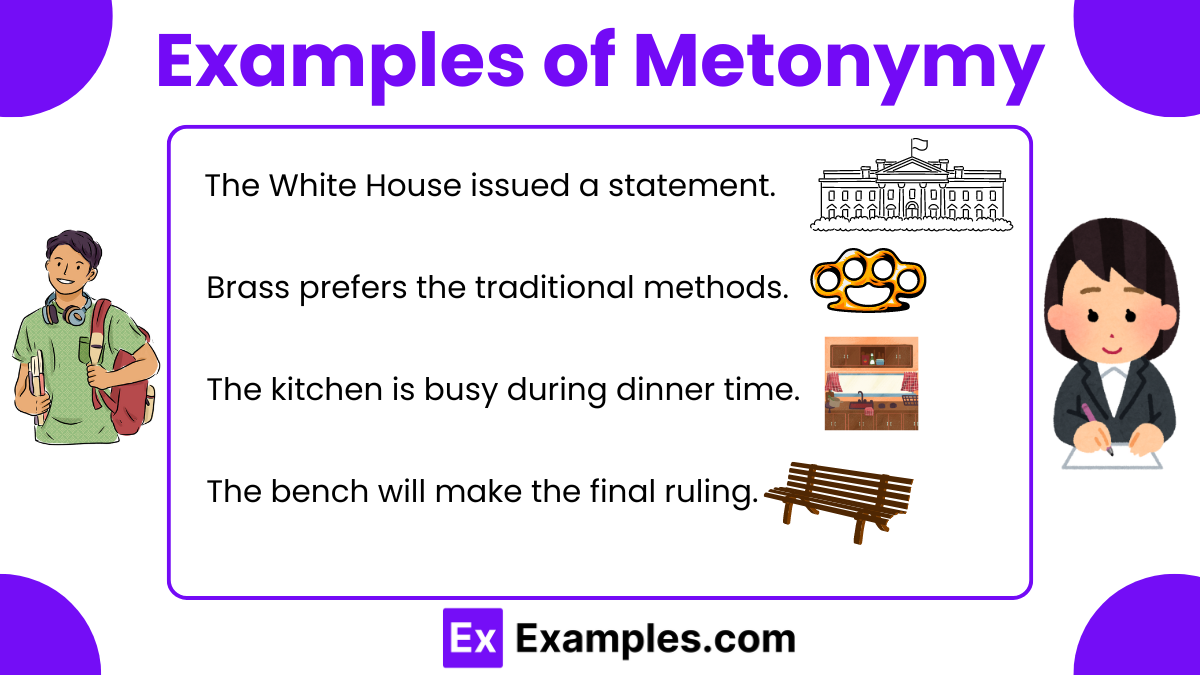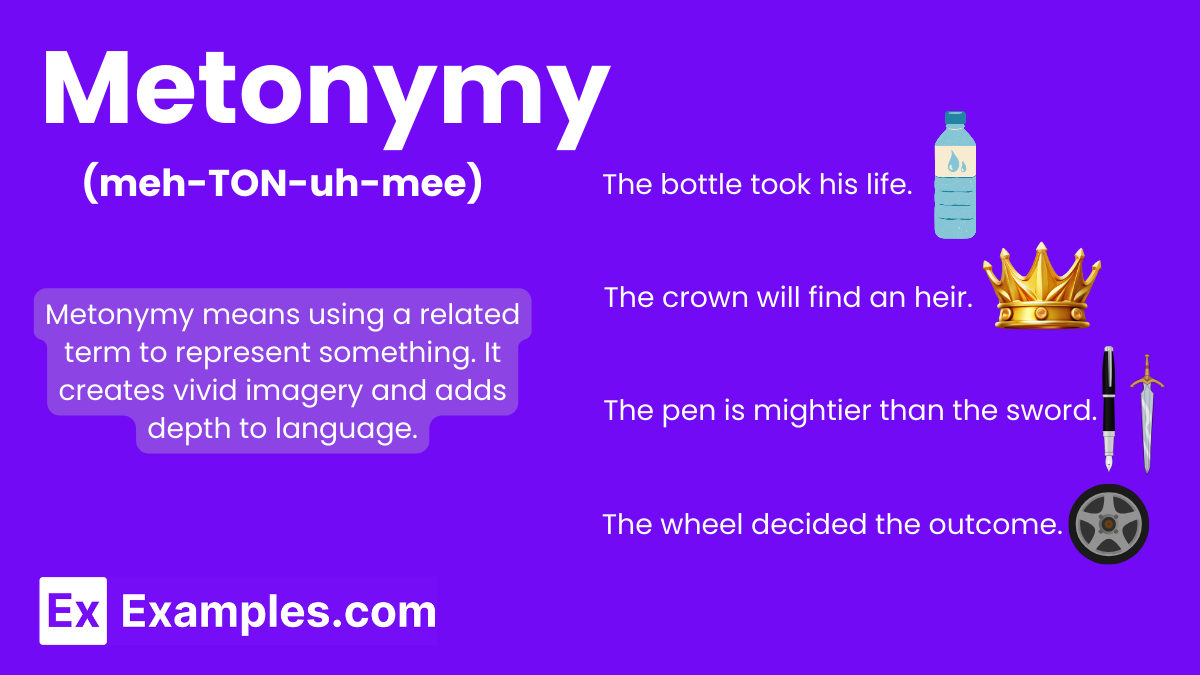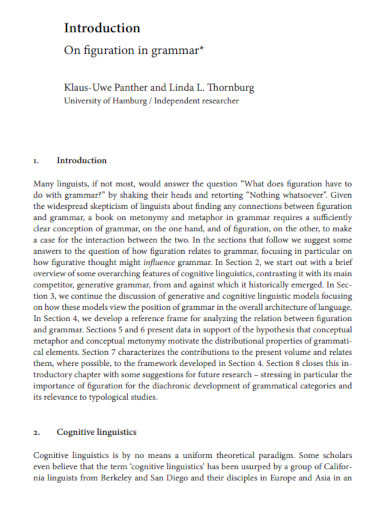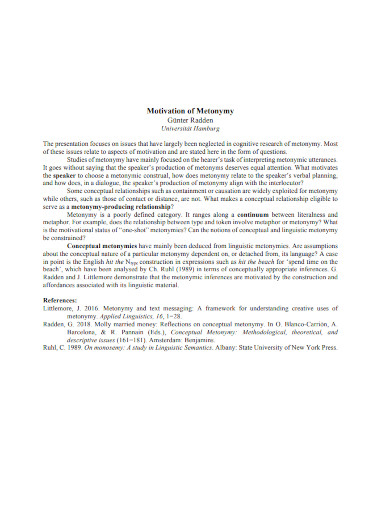90+ Metonymy Examples
Metonymy is a literary device in English where a word or phrase is substituted with another that is closely associated with it. This technique helps create vivid imagery and can make language more engaging. For example, using “the crown” to refer to a king or queen, or “the White House” to signify the President of the United States, are both instances of metonymy. This device is commonly used in literature and everyday language to add depth and meaning, making communication more effective and expressive.
What is Metonymy?
Examples of Metonymy

- The White House issued a statement.
- Hollywood is releasing many new movies this year.
- Wall Street is in turmoil.
- The pen is mightier than the sword.
- The crown will find an heir.
- He has a good head on his shoulders.
- Silicon Valley is known for tech innovations.
- The Pentagon announced new policies.
- The bottle took his life.
- The press is relentless.
- Brass prefers the traditional methods.
- She’s got a lot of heart.
- The suits in the boardroom made the decision.
- The stage was lively with performances.
- The bench will make the final ruling.
- His hand in the matter was evident.
- The lab made a breakthrough.
- The Oval Office is the power center.
- The kitchen is busy during dinner time.
- The wheel decided the outcome.
Examples of Metonymy in Everyday Life
- The White House issued a statement.
- Hollywood is releasing new blockbusters.
- Wall Street was in a panic today.
- The press is very active.
- He took to the podium.
- Silicon Valley has many startups.
- The crown will decide.
- The bench will rule soon.
- The pen outlasts the sword.
- Main Street is thriving.
Examples of Metonymy in Movies
- The Oscars celebrated the best in film.
- The silver screen has many classics.
- The box office was booming.
- Tinseltown is full of stars.
- He won at the Golden Globes.
- The director’s chair is powerful.
- The red carpet was glamorous.
- The big screen offers a different experience.
- The studio approved the script.
- The script was a masterpiece.
Examples of Metonymy in the Bible
- The rod and staff comfort me (Psalm 23:4).
- The cup of wrath (Jeremiah 25:15).
- Jerusalem will be rebuilt (Isaiah 44:26).
- The altar speaks (Revelation 16:7).
- The scepter shall not depart from Judah (Genesis 49:10).
- The lion of Judah (Revelation 5:5).
- The seed of Abraham (Galatians 3:16).
- The throne of David (Acts 2:30).
- The cross represents sacrifice.
- The vineyard of the Lord (Isaiah 5:7).
Examples of Metonymy in Literature
- The crown must find an heir (Shakespeare).
- The pen represents authorship (Marlowe).
- The fleet sailed at dawn (Homer).
- The throne was challenged (Tolkien).
- The sword signifies conflict (Chaucer).
- The bench made a judgment (Dickens).
- The hearth symbolizes home (Bronte).
- The kettle is boiling (Joyce).
- The White House responds (Orwell).
- The bottle represents alcohol (Hemingway).
Examples of Metonymy in Poetry
- The suits in the boardroom (Eliot).
- The crown will fall (Yeats).
- The pen weaves stories (Frost).
- The press spreads news (Pound).
- The sail signifies adventure (Coleridge).
- The bench stands firm (Wordsworth).
- The heart beats love (Browning).
- The cup of joy (Blake).
- The stage awaits (Shakespeare).
- The sword of justice (Milton).
Examples of Metonymy in Songs
- The bottle took his life (Eric Clapton).
- The strings played a sad tune (Bob Dylan).
- The mic is hot tonight (Queen).
- The keys to the kingdom (Coldplay).
- The stage is calling (Adele).
- The silver screen lights up (Elton John).
- The ink dried on the page (Taylor Swift).
- The brass section blared (Miles Davis).
- The drums beat loudly (U2).
- The spotlight shines (Madonna).
Examples of Metonymy in Sentences
- The White House confirmed the news.
- Hollywood is buzzing with rumors.
- Wall Street saw a surge.
- The press reported the event.
- Main Street was busy today.
- The crown will announce it.
- The bench handed down the decision.
- He lives by the pen.
- The bottle was his downfall.
- Silicon Valley innovates constantly.
1. Metonymy and Metaphor in Grammar
2. Motivation of Metonymy Template
Functions of Metonymy
- Creates Vivid Imagery: Metonymy uses specific and relatable terms to paint a vivid picture in the reader’s mind, making descriptions more dynamic and engaging.
- Adds Depth and Meaning: It connects concepts and objects closely related, adding layers of meaning and depth to the text.
- Enhances Readability: Using familiar terms or phrases instead of more complex or abstract concepts makes the text easier to understand.
- Evokes Emotions: Metonymy can evoke emotions by using a term that carries emotional weight, thereby creating a stronger connection with the reader.
- Promotes Brevity: It allows writers to convey complex ideas succinctly by substituting a single word or phrase for a longer explanation.
- Establishes Context: Metonymy helps to establish the setting or context quickly by referencing a well-known element associated with the broader idea.
- Creates Symbolism: It imbues objects or terms with symbolic meaning, enhancing the thematic elements of the text.
- Facilitates Rhetorical Effect: Metonymy adds a persuasive element to writing, making arguments more compelling by linking ideas to powerful symbols.
- Encourages Reader Engagement: By using familiar references, metonymy engages readers and encourages them to make connections, increasing their involvement with the text.
- Enriches Language: It enriches the language by introducing variety and creativity, making the text more interesting and enjoyable to read.
Why do Writers Use Metonymy
Metonymy is a figure of speech where one term is substituted for another closely related concept. Writers use metonymy for several key reasons:
Enhancing Imagery and Symbolism
- Creates vivid imagery by using related concepts (e.g., “the crown” for royalty).
Creating a Sense of Connection
- Establishes relationships between different elements, making themes more cohesive.
Economy of Language
- Conveys meaning efficiently with fewer words (e.g., “the White House” for the U.S. President and administration).
Emotional Impact
- Evokes strong emotions by using familiar and relatable terms (e.g., “Hollywood” for the film industry).
Adding Depth and Layers of Meaning
- Enriches text with multiple connotations, encouraging deeper interpretation.
Enhancing Rhetorical and Poetic Effects
- Improves aesthetic quality, creating rhythm and memorable language.
Facilitating Understanding and Relatability
- Makes complex ideas more accessible and relatable through familiar terms.
How to Use Metonymy in a Sentence
A properly-used metonymy can easily relay the intended meaning to the viewers of the written work. If the person misuses a metonymy or does not establish a connection between the referred work, it can confuse and miscommunicate the wrong message to the reader.
Create an Outline of the Sentence
Start by creating an outline using an outline format or a reference for the sentence structure. This will help you plan out and properly pace the whole sentence you will create with the metonymy.
Choose a Word to Become a Metonymy
Select a word in the sentence structure you want to replace with a metonymy. You may have more than one word in the sentence become a metonymy, but just keep it within one to three references.
Research for Words that are Related to the Chosen Word
The substitute for the word should be something that has a similar context, theme, and tone to the chosen word. You may use various references to obtain a list of synonyms the chosen word has.
Create the Metonymy
After you have chosen a word that will represent or symbolize the chosen word, you will now create the metonymy. If you want to create more metonymies you may repeat steps 1 through 4 until you are satisfied.
What is an example of metonymy in a quote?
“The pen is mightier than the sword” uses metonymy by substituting “pen” for writing and “sword” for military force, emphasizing the power of words over violence.
What are metonymy and synecdoche give examples?
Metonymy substitutes a related term (e.g., “White House” for the U.S. President). Synecdoche uses a part to represent the whole (e.g., “wheels” for a car).
What is a visual example of metonymy?
A visual example of metonymy is using an image of the scales of justice to represent the legal system or fairness.
What is an example of metonymy in Harry Potter?
In Harry Potter, “The Ministry” refers to the entire wizarding government, using metonymy to represent the larger institution by a single department.
What is an example of metonymy in The Great Gatsby?
In The Great Gatsby, “West Egg” and “East Egg” are used metonymically to represent the new and old money societies.
What is metonymy in Shakespeare?
In Shakespeare’s Julius Caesar, “Friends, Romans, countrymen, lend me your ears,” uses “ears” as metonymy to represent listening or attention.
What is an example of metonymy in a famous poem?
In T.S. Eliot’s “The Love Song of J. Alfred Prufrock,” “I have measured out my life with coffee spoons” uses metonymy, with “coffee spoons” representing the mundane, repetitive aspects of life.
What is an example of metonymy with pen?
“The pen conquered nations” uses metonymy, with “pen” representing writing or intellectual power rather than physical conquest.
What is a metonymy in Fahrenheit 451?
In Fahrenheit 451, “The Hearth and the Salamander” uses “hearth” to represent the home and “salamander” for the firemen and their fire trucks.
Which is a common use of metonymy?
A common use of metonymy is using “the White House” to refer to the U.S. President and their administration, representing the whole institution by its location.





